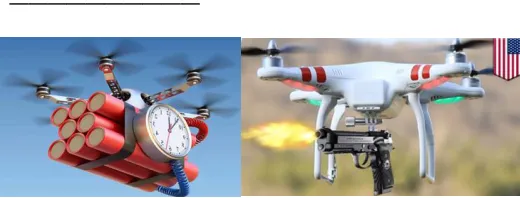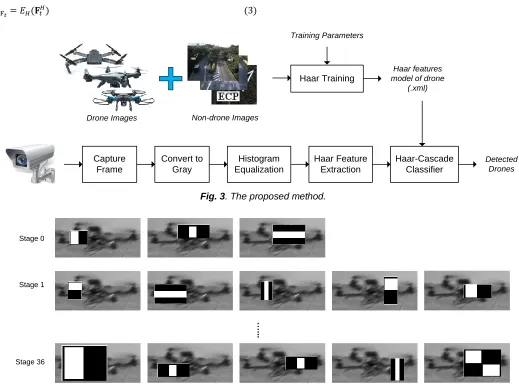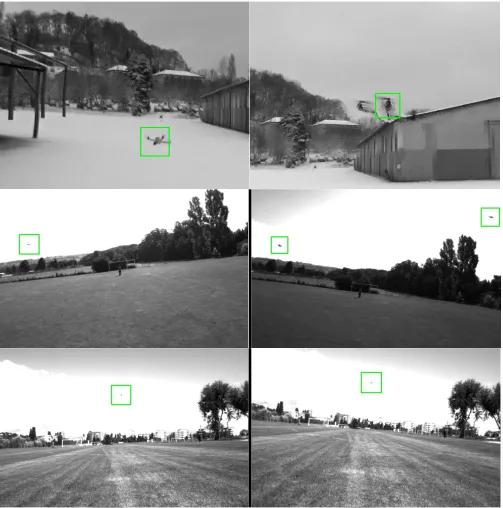2965
Drone Detection Experiment Based On Image
Processing And Machine Learning
Giao N. Pham, Phong H. NguyenAbstract: Drones are widely used in the field of information gathering and tracking, even they could be used to attacked targets. Therefore, the drone detection for the restricted areas or special zones is important and necessary. This paper focuses on the drone detection problem based on image processing for the restricted areas or special zones where used cameras for monitoring. The proposed solution detects drones from the captured images based on training the Haar-like features. The dataset of drone images is used in the Haar training process to generate a Haar-cascade model of drones. This model is then used to detect drones from images captured by the camera. The proposed solution is implemented and experimented with single cameras installed for any place including indoor environment and outdoor environment. Experimental results proved that the proposed solution could exactly detect drones for any zone or the restricted areas. The average accuracy of the proposed solution in the experimented environments is 91.9 %, and it provides an easy and economical solution for user.
Index Terms: Drone applications; Drone Security; Haar features; Haar training; Object detection.
—————————— ——————————
1.
INTRODUCTION
Drones are known as Unmanned Aerial Vehicles (UAV) is an aircraft without a human pilot aboard. Drones may operate with various degrees of autonomy either under remote control by a human operator or autonomously by onboard computers [1], [2]. Drones are originally used for missions too dirty or dangerous for humans while they originated mostly in military applications [3], [4]. Compared to the manned aircraft, drones are easily maneuverable and can be operated from anywhere. They provide greater visibility for the pilots operating them because they are guided by satellites and have highly advanced cameras. Nowadays, drones are rapidly used expanding to commercial, scientific, recreational, agricultural, and other applications such as policing, peacekeeping, surveillance, product deliveries, aerial photography, agriculture, smuggling, and drone racing [5]-[7]. Although drones are used to replace human in dangerous missions but they are also used for evil purposes. First of all, drone can scout targets and collect information from special zones or track moving objects as car, human for spying purposes without any detection. Secondly, drone can bring weapons to attack targets or bring bomb to terrorize public places without prevention as shown in Fig. 1. Thus, drone detection problem is important and necessary to ensure security for the restricted areas or special zones. In order to respond to above issue, we would like to propose a drone detection solution for the restricted areas or special zones based on image processing. The key content of the proposed solution is to use a dataset of drone images and non-drone images to create a Haar-cascade model for drones by the Haar training process. The trained Haar-cascade model of drones is then used in an image processing to detect drones by a Haar-cascade classifier from frames if drones appear in those
Fig. 1. Drone brings weapons to attack targets.
-frames. To clarify the proposed solution, we organize our paper as follow. In Sec. 2, we would like to explain the related works as Haar feature, Haar-cascade classifier, and drone detection. In Sec. 3, we present the proposed solution in detail. Experimental results and the evaluation of the proposed solution will be described in Sec. 4. Sec. 5 shows the conclusion.
2 RELATED
WORK
2.1 Drone Detection
Currently, to detect drones or UAVs we have to use a drone detection system based on complex radar systems [8], [9]. This system is a complex combination of radars, sensors and other complex devices [10]-[12]. Drone detection systems use complex radars and sensors to detect drones based on detecting the signal of drones or using the scan wave of radars as described in Fig. 2a. These systems need a group of people to operate them, and they are often used in military purposes or special applications. Moreover, the price of drone detection systems is very expensive, and the maintenance process consumes a lot of money. So, they are unsuitable for small zones or personal purposes.
2.2 Haar-Cascade Classifier-Based Drone Detection Haar-cascade classifier-based object detection method is an effective object detection method. It is a machine learning based approach where a cascade function is trained from a set of positive and negative images. It is then used to detect objects in other images. The core basis of the Haar-cascade classifier is the Haar-like features [13]-[17]. These features ————————————————
Giao N. Pham is currently an IT professor in Dept. of Computing Fundamentals, FPT University, Hanoi, Vietnam. E-mail: ngocgiaofet@gmail.com, giaopn@fe.edu.vn
2966 use the change in contrast values between adjacent rectangular groups of pixels. The contrast variances between
(a) (b)
Fig. 2. (a) A drone detection system using radars [18], and (b) Common Haar features.
-values between adjacent rectangular groups of pixels. The contrast variances between the pixel groups are used to determine relative light and dark areas. Two or three adjacent groups with a relative contrast variance form a Haar-like feature. Fig. 2b shows common Haar-like features that is used to detect objects in an image. The Haar-like features can be easily scaled by changing the size of the pixel group being examined. This allows features to be used to detect objects with various sizes. Therefore, we could use Haar-cascade classifier to detect drone objects with various sizes in frames captured by the camera.
3 THE
PROPOSED
METHOD
3.1 Overview
The proposed solution includes two parts as shown in Fig. 3. First part is the training process. Second part is the drone detection. The input of training process is drone images (called positive images), non-drone images (called negative images), and training parameters. In the training process, a dataset of images (including drone images and non-drone images) and training parameters are used in the Haar training process to obtain a Haar-like features model of drone. The format of the Haar-like features model of drone is ―.xml‖ file. In the drone detection, the frame is captured by the camera and then converted to the gray image. This gray image will be equalized histogram [18] and used to extract the Haar-like features. Finally, the Haar-like features of the captured frame and the trained model are used as the input of the Haar-cascade classifier to detect drones.
3.2 Training Process
In order to train Haar features model of drone, two sets of images are needed. One set contains images or scenes that do not contain drone object, which is going to be detected. This set of images is referred to as the negative images. The other set of images, the positive images, contain one or more instances of drone object. The location of the objects within
the positive images is specified by: image name, the upper left pixel and the height, and width of the object. The training process obtains the final model in XML format by using Intel’s Open Computer Vision (Open-CV) library. The training parameters and the steps of the training process using Open-CV library is shown in [19], [20]. Fig. 4 describes the stages of the training process for a drone image.
3.3 Drone Detection
Assume that M is the Haar features model of drone after the Haar training process. It will be used to detect drones from frames captured by the camera in application part. Firstly, a configured camera captures frame from the restricted areas or special zones. Given is the current frame captured by that camera. The current frame is converted to the gray image
as shown in Eq. (1).
Due to the proposed solution is based on the Haar-like features which is based on the contrast adjustment of image, we have to equalize the histogram of the gray image . This means we have to convert the gray image to the equalized histogram image. Assume that the equalized histogram image is , and it will be obtained from the gray image by the ―Equalize Histogram Function‖ as shown in Eq. (2) with the is the ―Equalize Histogram Function‖ to convert the gray image to the equalized histogram image .
The equalized histogram image is then used to extract the Haar-like features. Actually, the Haar-like features of the equalized histogram image is a set of parameters and stored in XML file as the Haar feature model of drone M. So, to brief, we defined the Haar-like features of the equalized histogram image by the , and the feature extraction
2967
Fig.3. The proposed method.
Fig. 4. The training process for a drone image.
Finally, the Haar-like features and the trained model M are used as the inputs of the Haar-cascade classifier for the drone detection process. We firstly computed the error between the Haar-like features and the trained model M the ―Classifier‖
function as described in Eq. (4) with the is the error between the Haar-like features and the trained model M. After that the error will be compared to the threshold to determine that image contains drone or not drone as shown in Eq. (5).
{
4 EXPERIMENTAL
RESULTS
We implemented the proposed solution by using the image processing library OpenCV 3.4 and Visual Studio C++ 2017. Our experiments are setup and run on an Intel Core i7 Quad 3.5 – GHz, 8 GB of RAM, Windows 7 64-bits. A single cemara is setup and configured to monitor special zone and to record videos for experiments. We collected 2000 drone images from many types of drone with various colors and various sizes; and 2000 non-drone images in real conditions as birds, kites,
airplanes, helicopters for the Haar training process. The accuracy of the training process is 96.1 %. This result is relatively high. Because the proposed solution is based on the conventional techniques of image processing. The accuracy of the training process result is dependent on the accuracy of the training dataset. In order to increase the accuracy of the training process, we can standardize and increase the number of images in the training dataset. For applications using the Haar training process, we can increase the accuracy of the Haar training process by using the background images of the fixed environment that will be install applications.
TABLE 1. DRONE DETECTION RESULTS
Video Name
Size of Frame
Frame Rate
True Detection
Total Detection
Accuracy (%) Video 1 640x480 25f/s 360 390 92.30 Video 2 640x480 25f/s 130 144 93.70 Video 3 640x480 25f/s 115 129 91.40 Video 4 640x480 25f/s 26 30 90.33 Video 5 640x480 25f/s 150 161 93.60 Video 6 752x480 25f/s 143 161 90.08
Average Accuracy = 91.90 %
Drone Images Non-drone Images
Haar Training
Training Parameters
Haar features model of drone
(.xml)
Capture Frame
Convert to Gray
Histogram Equalization
Haar Feature Extraction
Haar-Cascade Classifier
Detected Drones
Stage 0
Stage 1
…
...
2968
2969
Fig. 6. Drone detection result for outdoor environment.
We used a single camera to record videos for our experiments. The detail of videos is shown in Tab. 1. The experimental environment for the proposed solution is both indoor environment and outdoor environment. The drone detection results are shown in Fig. 5 and Fig. 6. Fig. 5 shows the drone detection results for indoor environment, and Fig. 6 show the drone detection results for outdoor environment. Based on Fig. 5 and Fig. 6, we could conclude that although it still have false detections but the proposed solution detected drones in test videos well. The accuracy of the proposed solution is computed by Eq. (6) and shown in Tab. 1. With test videos in Tab. 1, the accuracy of the proposed solution is formed 90.08% to 93.70 %. The average accuracy of the proposed solution is 90.05% as shown in Tab. 1. The
accuracy of the proposed solution is dependent on the training dataset. In our experiments, we used a small training dataset, thus the average accuracy of the proposed method is understandable. The accuracy of the proposed solution can be increase by increasing the number of images in the training dataset, and for a fixed environment we can use the background frames of that environment to increase the accuracy of the Haar classifier.
2970 training datasets and experimental environment of those
methods are A cc u rac y ( % ) 0 20 40 60 80 100
Proposed Method Demirkir's Method Cuong's MethodMustafa's MethodUddin's Method
Fig.7. Accuracy of the proposed solution compared to previous methods.
-different, we will not compare the detail of the proposed solution to previous methods. We only compare the accuracy of the proposed solution to the accuracy of previous methods. In Demirkir’s method [21], they proposed an object detection using the Haar feature selection optimization and achieved max accuracy 85.2 %. In Cuong’s method [22], they proposed a face detection method using variance based Haar-like feature and support vector machine, and achieved average accurracy 84.48 % with two databases of faces. In Mustafa’s method [23], they used Haar-like feature and gentle adaboot classifier to detect obscenity. The average accuracy of their method is 82.89 %. In Uddin’s method [24], they used Haar-like feature for horse detection and the accuracy of their method is 63 %. In our solution, the average accuracy of the proposed solution is 91.90 %. This means the accuracy of the proposed solution is better than previous methods. Fig. 7 shows the accuracy of the proposed solution compared to previous methods.
5 CONCLUSION
In this paper, we proposed an effective solution to detect drones based on image processing. The proposed solution used the Haar-like features to detect drones from frames captured by a single camera. The proposed solution is implemented and experimented with both indoor environment and outdoor environment. It could exactly detect almost cases. The proposed solution is simple and easy to implement for personal purpose applications for any place. The proposed solution is also flexible to developers. Because developers can use their training dataset to develop their applications for specific purposes. This is an advantage of our solution. In future, we collect big datasets to improve the accuracy of the proposed solution and experiment the proposed solution with many place.
ACKNOWLEDGMENTS:
This work is supported by the FPT University, Hanoi, Vietnam and the Center of Machine Vision and Signal Analysis, University of Oulu, Finland.
REFERENCES
[1] How to Fly a Drone. UAV Coach Company.
https://uavcoach.com/how-to-fly-a-quadcopter-guide/ (accessed on 5 September 2019).
[2] Drone Operation and Management.
https://research.unsw.edu.au/drones (accessed on 5 September 2019).
[3] U. Gheorghe, D. Alexandra, and O. Mihaela, ―Unmanned Aerial Vehicle in Military Operations,‖ Scientific Research and Education in the Air Force-AFASES, pp. 199-205, 2016.
[4] S. Pedrozo, ―Swiss Military Drones and the Border Space: A Critical Study of the Surveillance Exercised By Border Guards,‖ Geogr. Helv., vol. 72, pp. 97–107, 2017.
[5] A. Restas, ―Drone Applications for Supporting Disaster Management,‖ World Journal of Engineering and Technology, vol. 3, pp. 316-321, 2015.
[6] S. Lee, and Y. Choi, ―Reviews of Unmanned Aerial Vehicle (Drone) Technology Trends and its Applications in the Mining Industry,‖ Journal Geo-system Engineering, vol. 19, pp. 197-204, 2016.
[7] G. David, ―Drone Applications for Environmental Management in Urban Spaces: A Review,‖ International Journal of Sustainable Land Use and Urban Planning, vol. 3, pp. 1-14, 2016.
[8] Could Airbus drone detection system help protect planes?
https://www.dailypost.co.uk/business/business-news/could-airbus-drone-detection-system-11200748, (accessed on 5 September 2019).
[9] Drone Detection Systems. https://coherent-receiver.com/1094/drone-detection-systems (accessed on 5 September 2019).
[10] B. Nuss, L. Sit, M. Fennel, J. Mayer, T. Mahler, and Z. Thomas, ―MIMO OFDM Radar System for Drone Detection,‖ Proc. of 18th International Radar Symposium, pp. 1-10, Prague, June 2016.
[11] K. W. Lee, K. M. Song, J. H. Song, C. H. Jung, W. K. Lee, M. J. Lee, and Y. K. Song, ―Implementation of Radar Drone Detection Based on ISAR Technique,‖ The Journal of Korean Institute of Electromagnetic Engineering and Science, vol. 28, pp. 159-162, 2017.
[12] J. Ochodnicky, Z. Matousek, B. Marian, and J. Kurty, ―Drone Detection by Ku-Band Battlefield Radar,‖ Proc. of 2017 International Conference on Military Technologies, pp. 613-616, Czech Republic, 2nd June, 2017.
[13] P. Viola, and J. Michael, ―Rapid Object Detection using a Boosted Cascade of Simple Features,‖ Proc. of Conference on Computer Vision and Pattern Recognition, pp. 1-9, 2001.
[14] A. Mohamed, A. Issam, B. Mohamed, and B. Abdellatif, ―Real-time Detection of Vehicles Using the Haar-like Features and Artificial Neuron Networks,‖ Procedia Computer Science, vol. 73, pp. 24-31, 2015.
[15] M. S. Uddin, and A. Y. Akhi, ―Horse Detection Using Haar-Like Features,‖ International Journal of Computer Theory and Engineering, vol. 8, pp. 415-418, 2016.
[16] S. K. Pavani, D. Delgado, and A. F. Frangi, ―Haar-Like Features with Optimally Weighted Rectangles for Rapid Object Detection,‖ Pattern Recognition, vol. 43, pp. 160-172, 2010.
2971 [18] Histogram Equalization.
https://www.math.uci.edu/icamp/courses/math77c/demos/ hist_eq.pdf (accessed on 14 August 2019).
[19] Cascade Classifier Training.
https://docs.opencv.org/3.3.0/dc/d88/tutorial_traincascade .html, (accessed on 5 September 2019).
[20] Creating a Cascade of Haar-Like Classifiers: Step by Step.
https://www.cs.auckland.ac.nz/~m.rezaei/Tutorials/Creatin
g_a_Cascade_of_Haar-Like_Classifiers_Step_by_Step.pdf, (accessed on 5 September 2019).
[21] C. Demirkir, and B. Sankurur, ―Object Detection Using Haar Feature Selection Optimization,‖ Proc. of IEEE 14th Signal Processing and Communications Applications, Antalya, April 2006.
[22] Cuong, N. K.; Park, J. H.; and Jung, H. Y. Face Detection using Variance based Haar-Like feature and SVM. International Journal of Computer and Information Engineering 2009, 3 (12), 2947-2950. DOI: scholar.waset.org/1307-6892/5120
[23] R. Mustafa, Y. Min, and D. Zhul, ―Obscenity Detection Using Haar-Like Features and Gentle Adaboost Classifier,‖ The Scientific World Journal, 2014.

![Fig. 2. (a) A drone detection system using radars [18], and (b) Common Haar features.](https://thumb-us.123doks.com/thumbv2/123dok_us/8639892.1429600/2.612.52.569.80.269/fig-drone-detection-using-radars-common-haar-features.webp)


